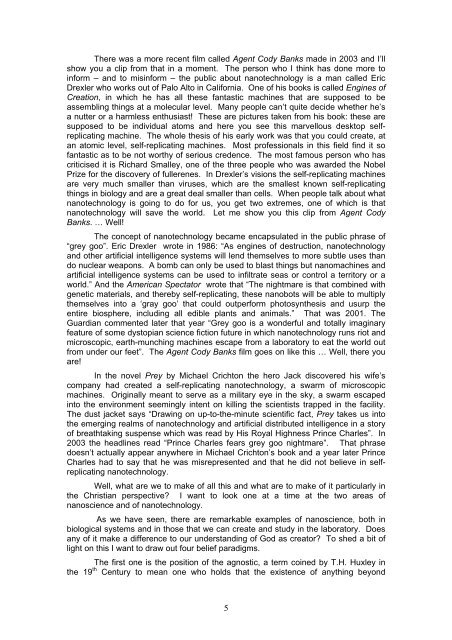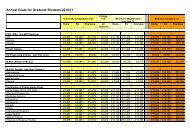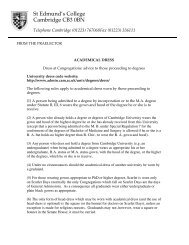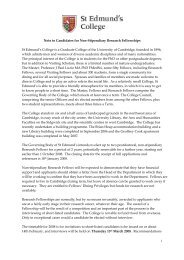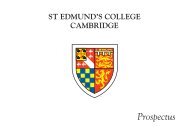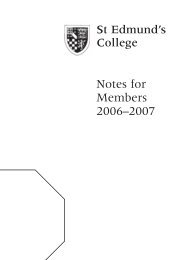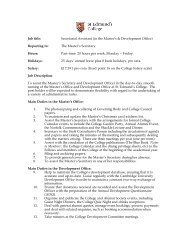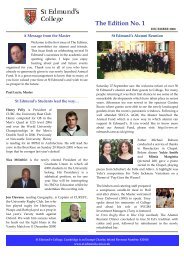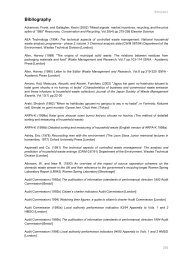Lecture - St Edmund's College - University of Cambridge
Lecture - St Edmund's College - University of Cambridge
Lecture - St Edmund's College - University of Cambridge
You also want an ePaper? Increase the reach of your titles
YUMPU automatically turns print PDFs into web optimized ePapers that Google loves.
There was a more recent film called Agent Cody Banks made in 2003 and I’ll<br />
show you a clip from that in a moment. The person who I think has done more to<br />
inform – and to misinform – the public about nanotechnology is a man called Eric<br />
Drexler who works out <strong>of</strong> Palo Alto in California. One <strong>of</strong> his books is called Engines <strong>of</strong><br />
Creation, in which he has all these fantastic machines that are supposed to be<br />
assembling things at a molecular level. Many people can’t quite decide whether he’s<br />
a nutter or a harmless enthusiast! These are pictures taken from his book: these are<br />
supposed to be individual atoms and here you see this marvellous desktop selfreplicating<br />
machine. The whole thesis <strong>of</strong> his early work was that you could create, at<br />
an atomic level, self-replicating machines. Most pr<strong>of</strong>essionals in this field find it so<br />
fantastic as to be not worthy <strong>of</strong> serious credence. The most famous person who has<br />
criticised it is Richard Smalley, one <strong>of</strong> the three people who was awarded the Nobel<br />
Prize for the discovery <strong>of</strong> fullerenes. In Drexler’s visions the self-replicating machines<br />
are very much smaller than viruses, which are the smallest known self-replicating<br />
things in biology and are a great deal smaller than cells. When people talk about what<br />
nanotechnology is going to do for us, you get two extremes, one <strong>of</strong> which is that<br />
nanotechnology will save the world. Let me show you this clip from Agent Cody<br />
Banks. … Well!<br />
The concept <strong>of</strong> nanotechnology became encapsulated in the public phrase <strong>of</strong><br />
“grey goo”. Eric Drexler wrote in 1986: “As engines <strong>of</strong> destruction, nanotechnology<br />
and other artificial intelligence systems will lend themselves to more subtle uses than<br />
do nuclear weapons. A bomb can only be used to blast things but nanomachines and<br />
artificial intelligence systems can be used to infiltrate seas or control a territory or a<br />
world.” And the American Spectator wrote that “The nightmare is that combined with<br />
genetic materials, and thereby self-replicating, these nanobots will be able to multiply<br />
themselves into a ‘gray goo’ that could outperform photosynthesis and usurp the<br />
entire biosphere, including all edible plants and animals.” That was 2001. The<br />
Guardian commented later that year “Grey goo is a wonderful and totally imaginary<br />
feature <strong>of</strong> some dystopian science fiction future in which nanotechnology runs riot and<br />
microscopic, earth-munching machines escape from a laboratory to eat the world out<br />
from under our feet”. The Agent Cody Banks film goes on like this … Well, there you<br />
are!<br />
In the novel Prey by Michael Crichton the hero Jack discovered his wife’s<br />
company had created a self-replicating nanotechnology, a swarm <strong>of</strong> microscopic<br />
machines. Originally meant to serve as a military eye in the sky, a swarm escaped<br />
into the environment seemingly intent on killing the scientists trapped in the facility.<br />
The dust jacket says “Drawing on up-to-the-minute scientific fact, Prey takes us into<br />
the emerging realms <strong>of</strong> nanotechnology and artificial distributed intelligence in a story<br />
<strong>of</strong> breathtaking suspense which was read by His Royal Highness Prince Charles”. In<br />
2003 the headlines read “Prince Charles fears grey goo nightmare”. That phrase<br />
doesn’t actually appear anywhere in Michael Crichton’s book and a year later Prince<br />
Charles had to say that he was misrepresented and that he did not believe in selfreplicating<br />
nanotechnology.<br />
Well, what are we to make <strong>of</strong> all this and what are to make <strong>of</strong> it particularly in<br />
the Christian perspective? I want to look one at a time at the two areas <strong>of</strong><br />
nanoscience and <strong>of</strong> nanotechnology.<br />
As we have seen, there are remarkable examples <strong>of</strong> nanoscience, both in<br />
biological systems and in those that we can create and study in the laboratory. Does<br />
any <strong>of</strong> it make a difference to our understanding <strong>of</strong> God as creator? To shed a bit <strong>of</strong><br />
light on this I want to draw out four belief paradigms.<br />
The first one is the position <strong>of</strong> the agnostic, a term coined by T.H. Huxley in<br />
the 19 th Century to mean one who holds that the existence <strong>of</strong> anything beyond<br />
5


